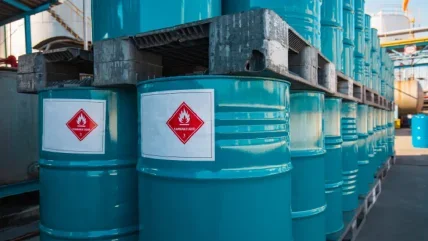
Global oil markets continued their downward trajectory on Wednesday, with prices falling to their lowest levels since February 2021 as US President Donald Trump’s newly implemented tariffs came into effect.
The latest duties, described as “reciprocal” by the White House, took effect from 12:01 AM EDT (0401 GMT), escalating trade tensions and deepening concerns about the outlook for global fuel demand.
Brent crude futures dropped $2.1, or 3.34%, to $60.72 per barrel by 0935 GMT, while US West Texas Intermediate (WTI) crude declined $2.04, or 3.42%, to $57.54. Both benchmarks had fallen by up to 4% earlier in the session before trimming some of the losses, according to Reuters.
The tariff escalation, which includes a 104% levy on Chinese imports, has raised fears that prolonged trade disputes between the US and major partners could significantly slow economic activity. Analysts observed that global industrial output and energy consumption may weaken further if diplomatic negotiations fail to progress.
As oil prices fell for a fifth consecutive day, Russia’s ESPO Blend crude also slipped below the G7-led $60 per barrel Western price cap for the first time, prompting speculation over potential implications for Russian export policy and enforcement of the cap.
Ashley Kelty, an analyst at Panmure Liberum, said the US administration may be aiming to bring oil prices closer to $50 per barrel, assuming domestic producers could endure short-term disruptions.
Kelty added: “We see this goal as somewhat delusional … and (it) will merely see US production shut in and open the door for OPEC to reclaim its position as the swing producer.”
In parallel, geopolitical responses intensified. The European Union was expected to approve retaliatory measures against Washington’s tariffs, joining Canada and China in counteraction.
China’s government refused to roll back its 34% retaliatory tariffs, calling the US stance “blackmail”. The Trump administration then moved ahead with an additional 50% duty on selected Chinese products.
Ye Lin, vice president of oil commodity markets at Rystad Energy, warned that the escalation could further delay any agreement between the US and China.
She said: “China’s aggressive retaliation diminishes the chances of a quick deal between the world’s two biggest economies, triggering mounting fears of economic recession across the globe.”
Ye also noted that China’s projected oil demand growth of 50,000 to 100,000 barrels per day could be jeopardised if the conflict endures, though domestic stimulus could potentially offset part of the decline.
Adding further pressure, OPEC+, which comprises the Organization of the Petroleum Exporting Countries (OPEC) and allies such as Russia, confirmed plans to raise production by 411,000 barrels per day in May. Market analysts said the move could tip the market into surplus and extend the period of downward pressure on prices.
In response to evolving market conditions, Goldman Sachs revised its price outlook.
The bank now expects Brent crude to fall to $62 per barrel by December 2025, and to $55 by the end of 2026. WTI prices are forecast to reach $58 by the end of 2025 and decline to $51 by the close of 2026.
While broader signals pointed towards weakening demand, recent US inventory data provided a partial offset. The American Petroleum Institute reported a 1.1 million barrel drop in US crude stocks for the week ending 4 April, compared to expectations of a 1.4 million barrel build as forecast by a Reuters poll.






